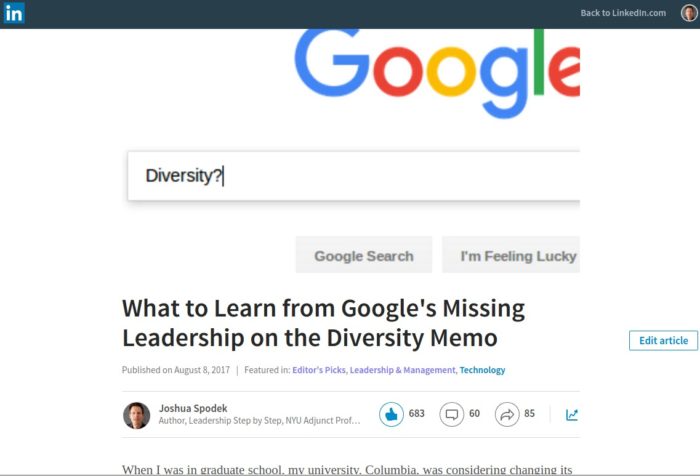My post on LinkedIn yesterday, “What to Learn from Google’s Missing Leadership on the Diversity Memo,” has 683 upvotes so far. It begins

What to Learn from Google’s Missing Leadership on the Diversity Memo
When I was in graduate school, my university, Columbia, was considering changing its policy on allowing ROTC on campus. The university president, Lee Bollinger, scheduled a town hall to hear views from the community.
Young, self-righteous, and angry, I went, intending to let Bollinger have a piece of my mind: how could he consider changing a policy students fought so hard to establish, that has stood so long?!?
At the town hall, some people shouted one way, others in others. Bollinger did something I’d never seen before. Instead of supporting one view or another, he made sure everyone’s voice was heard. He focused on the process.
Despite myself, I felt my anger dissipate as I heard others express my views. By the time I spoke, I felt included in the process.
The experience was one of my top leadership lessons:
You can make people feel understood and supported without agreeing with or supporting their ideas.
When you do, people like following you. The experience led, decades later, in part, to my book’s subtitle: Leadership Step by Step: Become the Person Others Follow.
Google today
A Google engineer spoke his mind, in writing. Whether you agree with him or not, whether posting so publicly was effective, he seems to have meant to provoke debate, not put anyone down.
Google fired him. The CEO, Sindar Pichai, probably felt compelled to act. To lead. He probably felt he was leading.
He wasn’t leading. He was reacting.
Rising and aspiring leaders—maybe you—can learn from his lack of leadership.
Read the rest at What to Learn from Google’s Missing Leadership on the Diversity Memo.
